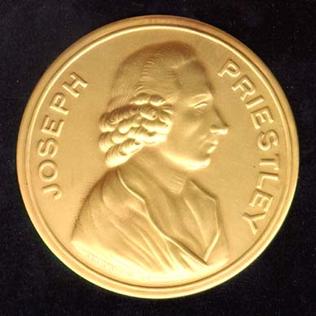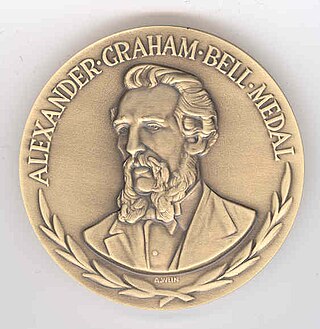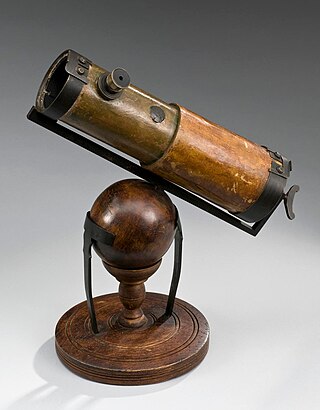Optica, founded as the Optical Society of America, is a professional society of individuals and companies with an interest in optics and photonics. It publishes journals, organizes conferences and exhibitions, and carries out charitable activities.

The Wollaston Medal is a scientific award for geology, the highest award granted by the Geological Society of London.
The Helen B. Warner Prize for Astronomy is awarded annually by the American Astronomical Society to a young astronomer for a significant contribution to observational or theoretical astronomy.

The Navy Distinguished Service Medal is a military decoration of the United States Navy and United States Marine Corps which was first created in 1919 and is presented to Sailors and Marines to recognize distinguished and exceptionally meritorious service to the United States while serving in a duty or position of great responsibility.

The Priestley Medal is the highest honor conferred by the American Chemical Society (ACS) and is awarded for distinguished service in the field of chemistry. Established in 1922, the award is named after Joseph Priestley, one of the discoverers of oxygen, who immigrated to the United States of America in 1794. The ACS formed in 1876, spearheaded by a group of chemists who had met two years previously in Priestley's home.
The Henry Marshall Tory Medal is an award of the Royal Society of Canada "for outstanding research in a branch of astronomy, chemistry, mathematics, physics, or an allied science". It is named in honour of Henry Marshall Tory and is awarded bi-annually. The award consists of a gold plated silver medal.
SPIE is an international not-for-profit professional society for optics and photonics technology, founded in 1955. It organizes technical conferences, trade exhibitions, and continuing education programs for researchers and developers in the light-based fields of physics, including: optics, photonics, and imaging engineering. The society publishes peer-reviewed scientific journals, conference proceedings, monographs, tutorial texts, field guides, and reference volumes in print and online. SPIE is especially well-known for Photonics West, one of the laser and photonics industry's largest combined conferences and tradeshows which is held annually in San Francisco. SPIE also participates as partners in leading educational initiatives, and in 2020, for example, provided more than $5.8 million in support of optics education and outreach programs around the world.
The Guy Medals are awarded by the Royal Statistical Society in three categories; Gold, Silver and Bronze. The Silver and Bronze medals are awarded annually. The Gold Medal was awarded every three years between 1987 and 2011, but is awarded biennially as of 2019. They are named after William Guy.
The Roebling Medal is the highest award of the Mineralogical Society of America for scientific eminence as represented primarily by scientific publication of outstanding original research in mineralogy. The award is named for Colonel Washington A. Roebling (1837–1926) who was an engineer, bridge builder, mineral collector, and significant friend of the Mineralogical Society of America. It is awarded for scientific eminence represented by scientific publication of outstanding original research in mineralogy. The recipient receives an engraved medal and is made a Life Fellow of the Mineralogical Society.
The IEEE Edison Medal is presented by the Institute of Electrical and Electronics Engineers (IEEE) "for a career of meritorious achievement in electrical science, electrical engineering, or the electrical arts." It is the oldest medal in this field of engineering. The award consists of a gold medal, bronze replica, certificate, and honorarium. The medal may only be awarded to a new leap/breakthrough in the technological area of science.

The IEEE Alexander Graham Bell Medal is an award honoring "exceptional contributions to communications and networking sciences and engineering" in the field of telecommunications. The medal is one of the highest honors awarded by the Institute of Electrical and Electronics Engineers (IEEE) for achievements in telecommunication sciences and engineering.

The University of Arizona College of Optical Sciences, considered the largest institute for optics education in the United States, is dedicated to research and education in optics with an emphasis on optical engineering. The college offers more than 90 courses in optical sciences, and a Bachelor of Science degree in Optical Sciences and Engineering, Masters and Doctoral degree programs in Optical Sciences, as well as a dual master's degree in Optical Sciences and Business Administration. The college also offers comprehensive distance learning courses leading to a Professional Graduate Certificate or a master's degree and markets non-credit short courses on DVD to optics professionals.

The Isaac Newton Medal and Prize is a gold medal awarded annually by the Institute of Physics (IOP) accompanied by a prize of £1,000. The award is given to a physicist, regardless of subject area, background or nationality, for outstanding contributions to physics. The award winner is invited to give a lecture at the Institute. It is named in honour of Sir Isaac Newton.

The NASA Outstanding Leadership Medal is awarded to US government employees only for notably outstanding leadership which affects technical or administrative programs of NASA. The leadership award may be given for an act of leadership, for sustained contributions based on a leader's effectiveness, for the productivity of the leader's program, or for the leader's demonstrated ability in developing the administrative or technical talents of other employees.
Paul Bruce Corkum is a Canadian physicist specializing in attosecond physics and laser science. He holds a joint University of Ottawa–NRC chair in attosecond photonics. He also holds academic positions at Texas A&M University and the University of New Mexico. Corkum is both a theorist and an experimentalist.

The American Institute of Chemists Gold Medal is the highest award of the American Institute of Chemists and has been awarded since 1926.
The John Fritz Medal has been awarded annually since 1902 by the American Association of Engineering Societies (AAES) for "outstanding scientific or industrial achievements". The medal was created for the 80th birthday of John Fritz, who lived between 1822 and 1913. When AAES was dissolved in 2020, the administration of the Fritz medal was transferred to the American Institute of Mining, Metallurgical, and Petroleum Engineers (AIME), and is currently coordinated by AIME member society, the Society of Mining, Metallurgy, & Exploration (SME).
The R.A.F. Penrose Gold Medal was established in 1923 and is awarded by the Society of Economic Geologists (SEG) to recognize a full career in the performance of "unusually original work in the earth sciences". The medal was donated by American geologist and founding President of the SEG Richard A.F. Penrose Jr. At the time of its donation, Penrose was explicit in his desire that the medal be awarded for achievements in pure geological science, rather than in the application of science to the discovery of mineral deposits.
The William H. Nichols Medal is awarded annually for original research in chemistry. Nominees must have made a "significant and original contribution in any field of chemistry" during the five years preceding the presentation date. The medallist receives a gold medal, a bronze replica and a cash award. The award was established in 1902 by the New York Section of the American Chemical Society (ACS) through a gift from chemist and businessman William H. Nichols. It was the first award to be approved by the ACS. The medal was first awarded in 1903.
Michael W. Berns was an American biologist who was a professor of surgery and cell biology at the University of California, Irvine (UCI), and an adjunct professor of bioengineering at the University of California, San Diego. Berns was a founder of the first Laser Microbeam Program (LAMP), the Beckman Laser Institute, the UCI Center for Biomedical Engineering, and the UCI Photonics Incubator.







